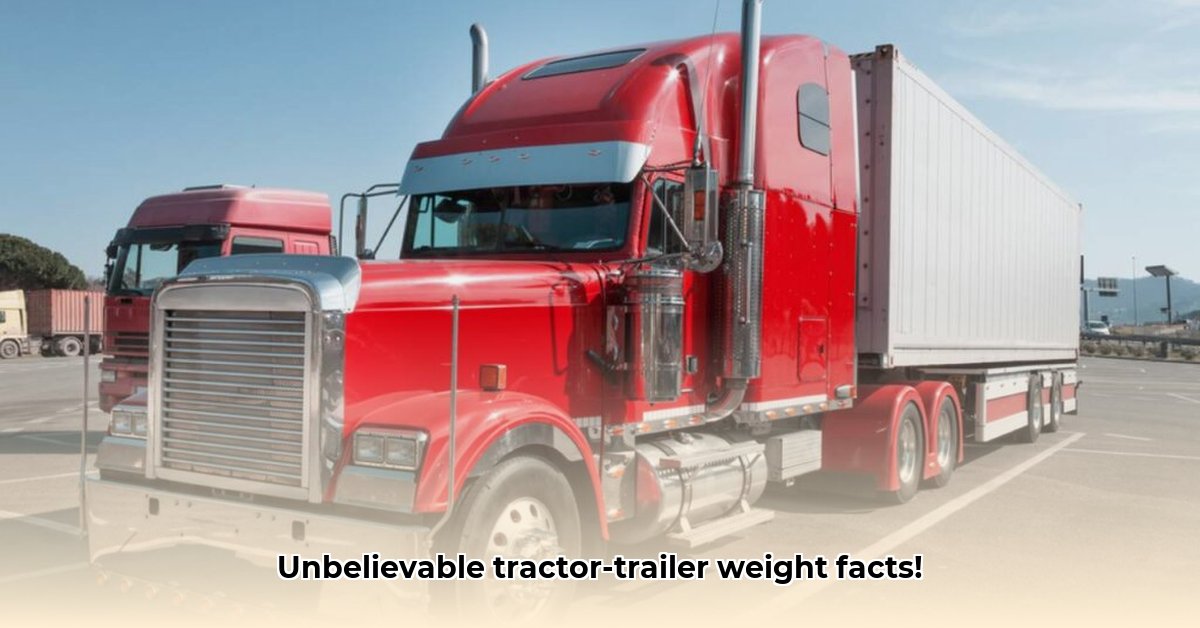
Ever wondered about the weight of a tractor-trailer? It's far more complex than a single number. This comprehensive guide explores the many factors influencing a tractor-trailer's weight, relevant regulations, and best practices for safe and legal operation. Whether you're a trucking professional, a regulator, or simply curious, this guide provides a clear understanding of this critical aspect of the trucking industry. For information on financing, check out this guide on tractor trailer financing.
How Much Does a Tractor Trailer Weigh?
Determining the weight of a tractor-trailer isn't straightforward. Several factors significantly impact the overall weight, creating a wide range of possibilities. Let's break down the key variables.
Empty vs. Loaded Weight: A Significant Difference
The weight of an empty tractor-trailer differs dramatically from its weight when fully loaded. A typical empty tractor-trailer might weigh approximately 30,000 pounds, but this is just a starting point. The type of trailer significantly affects empty weight. A dry van trailer (a standard enclosed trailer) might weigh around 10,000 pounds empty, while a flatbed or refrigerated ("reefer") trailer will have different weights. The cargo itself adds substantial weight, making this a crucial factor in overall weight calculations.
Cargo Weight: The Major Variable
Cargo weight is the most significant variable. A trailer full of lightweight materials will weigh considerably less than a trailer carrying dense materials like steel. Precise cargo weight determination is critical for legal and safe operation. Overloading is dangerous, illegal, and costly, leading to fines and potentially serious accidents. Different cargo types require different trailers, further impacting the overall weight. For example, oversized or heavy machinery often needs specialized lowboy trailers.
Legal Weight Limits: Navigating Regulations
The maximum legal gross weight for a tractor-trailer in the United States is often around 80,000 pounds. However, this is not universally applicable. State laws and specific route limitations (due to bridge weight restrictions or road conditions) can impose stricter limits. Truckers must be intimately familiar with these variations to avoid penalties and ensure safety. Ignoring these limits results in significant fines and poses a serious safety threat.
Axle Weight Distribution: A Critical Factor
Beyond the overall gross vehicle weight (GVW), axle weight distribution is crucial for safe and legal operation. Each axle has individual weight limits. Uneven weight distribution can damage roads, cause instability, and increase accident risk. Weight stations across the country randomly inspect trucks to ensure compliance with both GVW and axle weight limits.
Weight Management: A Shared Responsibility
Effective weight management requires a collaborative effort across all stakeholders in the trucking industry.
Trucking Companies:
- Invest in precise weighing equipment: Accurate scales are essential for load assessment.
- Comprehensive driver training: Education on weight limits, safe loading, and route planning is critical.
- Utilize weight-monitoring technology: GPS systems with weight monitoring capabilities offer real-time tracking and route optimization.
Drivers:
- Pre-trip weighing: Always weigh the loaded truck before departure to prevent violations.
- Thorough knowledge of regulations: Drivers must be fully informed about all applicable weight regulations and route restrictions.
- Immediate reporting: Report any suspected weight issues or loading problems to supervisors promptly.
Regulatory Agencies:
- Modernize weight-checking technology: Advanced technology at weigh stations increases efficiency and accuracy.
- Industry collaboration: Partnering with the trucking industry fosters best practices in weight management.
How to Calculate Tractor Trailer Weight Distribution for Optimal Safety
Key Takeaways:
- Understanding axle weight limits is crucial; exceeding them, even with a legal GVW, leads to violations.
- Accurate load planning and weight redistribution techniques are paramount for safe operation.
- Pre-trip weighings at certified scales are essential for compliance.
- State-specific regulations vary. Always verify local laws.
- Fuel weight and placement influence weight distribution.
- Optimal weight distribution improves fuel efficiency and reduces wear and tear.
- Technology, such as onboard weighing systems, enhances real-time monitoring.
Understanding Weight Limits and Axle Configurations
Legal weight limits vary by jurisdiction. A common GVW limit is 80,000 lbs, but this is accompanied by individual axle weight limits. These limits might include 12,000 lbs for the steer axle and 34,000 lbs for drive or tandem axles. Exceeding these limits is a violation, regardless of the GVW.
Practical Steps for Weight Distribution Management
Precise Weight Measurement: Use certified scales to measure total weight and axle weights. Remember to account for the tare weight (empty weight) of the truck and trailer.
Strategic Load Planning: Distribute heavier items centrally within the trailer to achieve even axle weight distribution. Proper weight balance is essential for safe handling and fuel efficiency.
Cargo Redistribution: If weighing reveals axle overload, carefully shift cargo to redistribute weight evenly.
Regular Weight Checks: Fuel consumption changes weight distribution over time. Regular checks, especially on long hauls, are advisable. Onboard weighing systems minimize the need for frequent stops at weigh stations.
Detailed Documentation: Maintain records of weight readings, load manifests, and adjustments made. This is critical for audits and regulatory compliance.
Advanced Considerations and Tools
Beyond avoiding fines, accurate load management is critical for driving safety. Factors such as the trailer's center of gravity and secure cargo are also vital. Specialized software can simulate different load configurations and help identify potential issues.
Regulatory Compliance and Best Practices
Always comply with all applicable federal and state regulations. Consult the FMCSA website https://www.fmcsa.dot.gov/ for detailed information.
Table: Typical Axle Weight Limits (Illustrative – Check Local Regulations)
| Axle Type | Weight Limit (lbs) |
|---|---|
| Steer Axle | 12,000 |
| Drive Axle | 34,000 |
| Tandem Axles | 34,000 |
Ignoring weight management has serious consequences beyond fines. It impacts safety, efficiency and equipment lifespan. Careful weight distribution is key to long-term operational success and safety in the trucking industry.